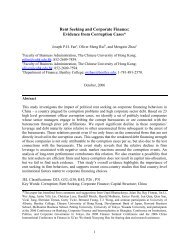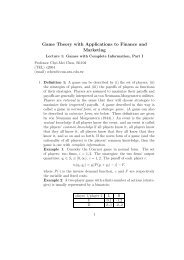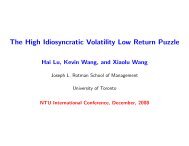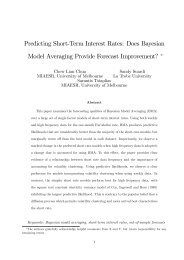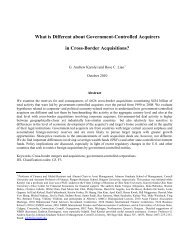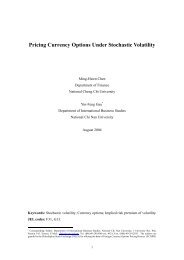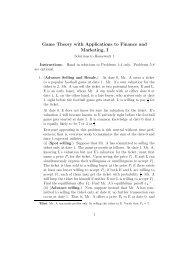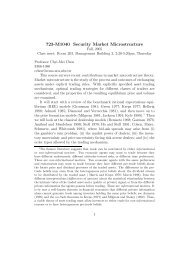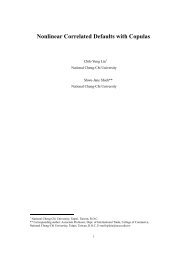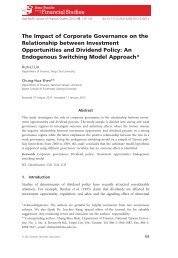Game Theory with Applications to Finance and Marketing
Game Theory with Applications to Finance and Marketing
Game Theory with Applications to Finance and Marketing
You also want an ePaper? Increase the reach of your titles
YUMPU automatically turns print PDFs into web optimized ePapers that Google loves.
does, although firm 2 is not fooled by firm 1’s date-1 action. As we<br />
explained in the above footnote, <strong>with</strong>out firm 1’s interference, firm 2<br />
will leave at date 2 <strong>with</strong> probability 1 − b, but in this equilibrium, firm<br />
2 will leave at date 2 for sure.<br />
Similarly, for the SPNE described in (2), firm 1’s date-1 equilibrium<br />
action is A, which generates perfect information for firm 2 about the<br />
latter’s type. Firm 2 will leave at date 2 if <strong>and</strong> only if it finds out that<br />
its type is B. Thus in equilibrium firm 1 gets zero at date 1, <strong>and</strong> it<br />
expects <strong>to</strong> get [b · 0 + (1 − b) · M] at date 2. What happens if firm<br />
1 secretly deviates at date 1 <strong>and</strong> chooses <strong>to</strong> prey? Without changing<br />
its belief about firm 1’s date-1 action, firm 2 will leave for sure after<br />
firm 1 preys at date 1. Thus firm 1’s payoff following this deviation is<br />
−c+M. We conclude that the SPNE described in (2) can be sustained<br />
if <strong>and</strong> only if<br />
−c + M ≤ 0 + [b · 0 + (1 − b) · M] ⇔ c ≥ bM.<br />
Finally, consider the SPNE described in (3). Let p > 0 be the prob.<br />
that firm 1 preys at t = 1. Then conditional on its date-1 profit being<br />
L, firm 2 thinks that its type is B <strong>with</strong> prob. 22<br />
1 − b<br />
p + (1 − p)(1 − b) =<br />
1 − b<br />
pb + (1 − b) > 1 − b,<br />
where the inequality explains why firm 1 would like <strong>to</strong> prey at date 1.<br />
However, in case<br />
pbH + (1 − b)L<br />
≥ 0,<br />
pb + (1 − b)<br />
2 at date 1, <strong>and</strong> thereby discouraging (credibly because it is an equilibrium) firm 2 from<br />
entering in the first place as long as entering incurs a fixed cost. In fact, Fudenberg <strong>and</strong><br />
Tirole consider a situation where firm 1 cannot destroy firm 2’s opportunity of getting the<br />
real option by preying at date 1. In equilibrium preying may still benefit firm 1 because<br />
before entering firm 2 realizes that its profits may be low because firm 1 always wants<br />
<strong>to</strong> manipulate its belief by preying at date 1, <strong>and</strong> preying (which is credible) lowers both<br />
firms’ profits.<br />
22 To see this, note that firm 2’s date-1 profit is always L if its type is B (occurring <strong>with</strong><br />
probability 1 − b), <strong>and</strong> its date-1 profit is L <strong>with</strong> probability p if its type is G (occurring<br />
<strong>with</strong> probability b).<br />
39



